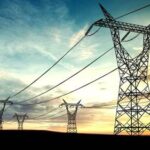Energy News Beat
When Congress voted to spend hundreds of billions to switch electricity production to solar and wind, it forgot something: transmission lines. New ones will be needed going to the locations of the new power sources, but nobody bothered to figure out who will pay for it or how much it will cost.
Congressmen Sean Casten (D-IL) and Mike Levin (D-CA) introduced a bill last month to fix their omission, largely at your expense. The bill has already picked up 76 co-sponsors, including eight from Illinois.
Grab your wallet. Here are the details:
In 2022, Congress passed the mislabeled Inflation Reduction Act (IRA), which will cost an estimated $1.2 trillion, far exceeding initial claims. The IRA actually was the largest energy bill in U.S. history. Tax credits for renewable energy production, among the biggest elements of the law, are estimated to cost $263 billion.
No cap was placed on those tax credits and they were generous – 30% of project costs. That’s part of the reason for the cost overrun but it also means that new solar and wind production projects are underway. All the better, say IRA supporters.
Now, however, there’s widespread, bipartisan recognition that those projects are futile without transmission linking them into the electrical grid. Progressive economist Paul Krugman, for example, cheered the IRA but wrote despairingly in the New York Times that “we may need a third, bureaucratic miracle to fix the electricity grid and make this whole thing work.”
Casten, also an avid IRA supporter, now admits to the gravity of the problem saying that “80% of the clean energy progress we made with the Inflation Reduction Act will be lost unless we reform transmission and permitting.”
Enter Casten and Levin with their solution, the Clean Electricity and Transmission Acceleration Act (CETA), which they introduced in the House last month.
What’s in it?
More tax credits, which is to say more subsidies by taxpayers. A 30% tax credit would go toward qualifying new transmission lines going to renewable sources. The total amount of credits available is again uncapped.
That’s just part of the 210-page bill. It would also amend the IRA to let the Department of Energy finance transmission facilities designated by DOE as “national interest.”
It would give the Federal Energy Regulatory Commission exclusive siting authority for “national interest” transmission lines, directing FERC to base its decision to exercise such authority on factors that include enabling the use of renewable energy. That’s important because it appears to be an attempt to override growing roadblocks local citizens have been putting up to new renewable projects on their landscape.
The bill also contains a range of provisions under the label of “empowerment.” It would, among many other things, establish an Office of Environmental Justice and External Civil Rights; codify the Office of Environmental Justice and External Civil Rights in the EPA; codify the White House Environmental Justice Interagency Council; provide for development an Interagency Federal Environmental Justice Strategy to address “current and historical environmental injustice,” and designate “Tribal Community Engagement Officers” in each agency.
The bill has 76 House co-sponsors and counting, all Democrats, in addition to Casten and Levin, including Illinoisans Jan Schakowsky, Nicole Budzinski, Jonathan Jackson, Eric Sorensen, Bill Foster, Brad Schneider, Raja Krishnamoorthi and Mike Quigley.
What will all this cost?
So far, I have seen nothing at all from bill sponsors or in the press. As always, cost matters little if the results are green.
But lots of evidence suggests that the cost would certainly be many tens of billions and perhaps hundreds of billions of dollars. For example, interconnection costs sometimes 10 times higher than projects that ultimately got built. Earlier this year, a renewable executive told The New York Times that interconnection costs have become the “no. 1 project killer.” For Texas alone, according to one study, extending the reach of transmission lines to connect more zero-carbon power sources would cost $11 billion by 2035.
And stories abound about individual projects facing huge interconnection problems. CNBC devoted a three-part series to it.
Remember that the cost to the government from tax credits or grants to fix the problem is just the start. Utilities would bear a large part of the remaining cost which gets passed through to consumers in rate increases. Insofar as other private sector investors fund the rest of the price, there’s an opportunity cost of capital that might have been invested elsewhere.
The bill has no chance of passing in its current form in the Republican-majority House. It’s important nevertheless because it represents the progressive starting point of negotiations on a massive problem that both parties recognize. Republicans unanimously opposed the IRA in the House and Senate, but may negotiate a bill to address the problem in order to salvage something of value from what’s already been spent.
The new bill is also important because it reflects the thinking of progressives and what they’d like to do if they regain full control of Congress. “While acknowledging that the bill stood little chance of passage in the current House,” The Hill reported, “Casten said it would serve as an ‘anchor of democratic energy policy when a window opens up to have that conversation again.”
Is the public ready to pay up once again for renewable electricity? Most Americans support renewable sources but want a balance with traditional, fossil fuel sources. Good. That’s sensible. But where’s the balance?
There’s a final, huge kicker near the end of the bill that has nothing to do with energy or transmission lines: It would amend the Civil Rights Act of 1964 to prohibit disparate impact discrimination.
I found the buried section by chance when going through the bill. No bill sponsor or reporter has mentioned it. “Disparate impact” is a critical issue in discrimination cases. It’s about whether the mere fact of unequal outcomes proves illegal discrimination and what excuses there may be for it. It’s complicated, and Supreme Court rulings depend on who is getting sued, among other variables.
Suffice it to say, however, that Section 603 of CETA would vastly expand the scope of what would constitute illegal discrimination under the Civil Rights Act, making it easier to sue based on unequal outcomes.
Why did they hide this proposal in an energy bill. Afraid of what voters would think it they put it up straight as a standalone bill?
Getting back to the main thrust of CETA, when Paul Krugman wrote that it would take a “bureaucratic miracle to fix the electricity grid and make this whole thing work,” he must have been fantasizing about CETA.
CETA is that fantasy and more.
The post Progressive Lawmakers Line Up Behind Costly Fix For Error They Made In Renewable Energy Plan appeared first on Energy News Beat.








